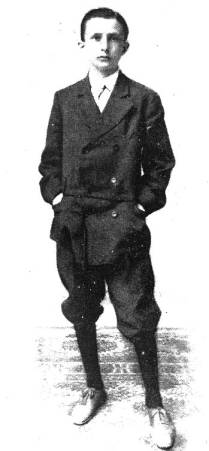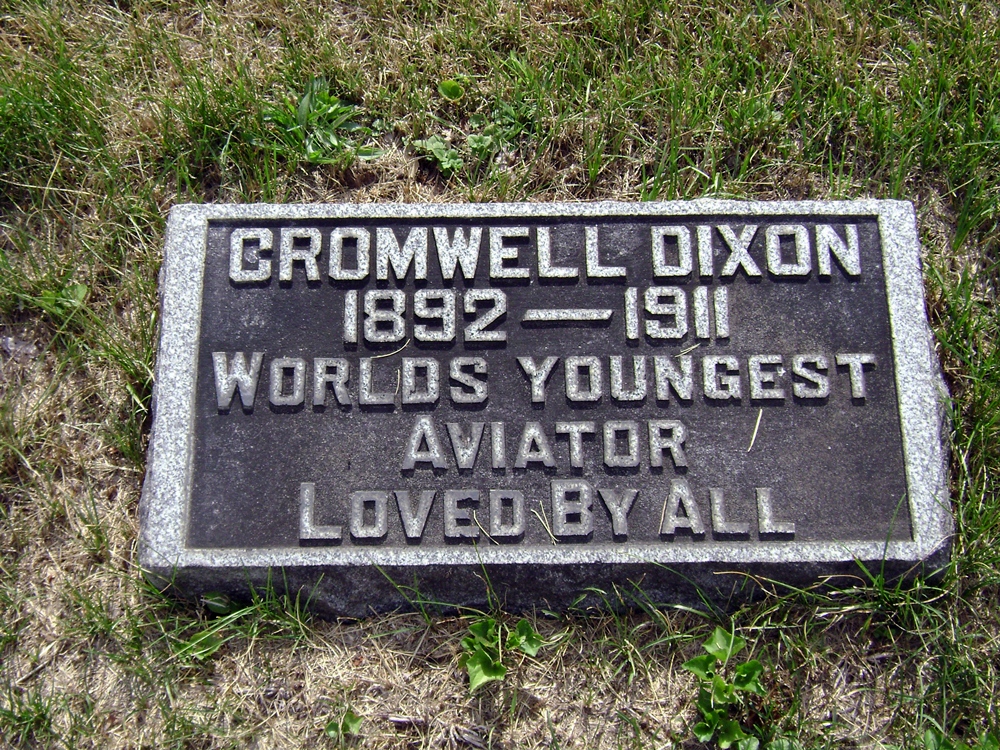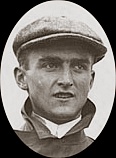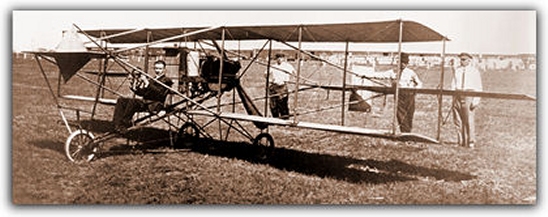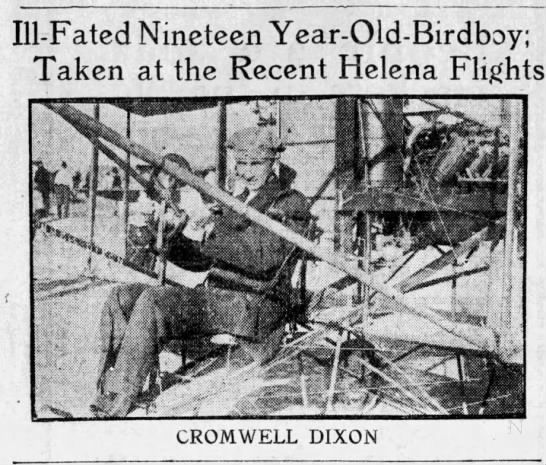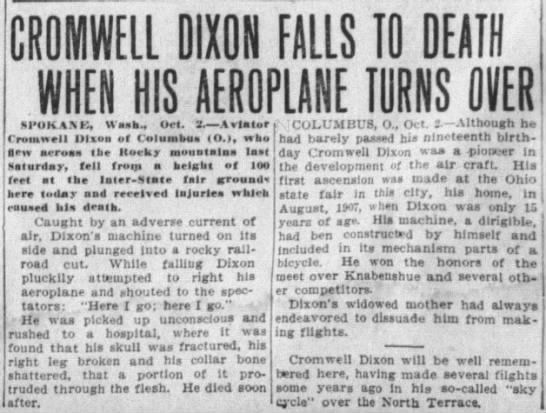Killed in air crash
Check out The History Detectives show online from 2010, Episode 8. There is an episode about Dixon's plane crash in Grand Island, Nebraska. The episode was filmed partially at the Stuhr Museum and I was interviewed for the show. The following is from a newsletter article for the Stuhr Museum that I helped write concerning Dixon's visit and crash in Grand Island in August/September 1911, shortly before his flying accross the Contindenal Divide in Montana and his death in Washington state.
Grand Island Aviation Meet
By Leslie Vollnogle and Jessica Waite
In 1911, just eight years after the Wright Brothers' first flight, thousands gathered in Grand Island for the city's first air show. The aviation meet was contracted with the Glenn Curtiss Aviation Company, who agreed to perform for three days. Spectators would be able to witness the "birdman" or aviator, "perform all sorts of aerial stunts and every effort possible will be put forth to make it the event of the season." The exhibition took place at Delwood Park, which was located on the eastern expanse of the old Hann Park on Locust Street.
The Curtiss Company had selected C. C. Witmer to be the pilot. Witmer became ill and was unable to fly. The Curtiss Company then chose Cromwell Dixon, the youngest licensed aviator in the United States, to replace Witmer. However, the day before the event was to start officials received a telegram stating that Dixon had been in an accident. His plane had been damaged and another aviator, Jimmie Ward, was to come in his stead.
On August 30, 1911, Jimmie Ward's plane, the Shooting Star, arrived in Grand Island without its aviator and Cromwell Dixon arrived without a plane. Unfamiliar with Ward's plane and without trained mechanics, Dixon had to set up the machine himself with the aid of several local machinists. Dixon's initial flight began well but due to his unfamiliarity with the plane, the landing proved to be ominous. The Grand Island Independent gives the following account of the crash:
"He alighted near the smooth, skimmed portion of the baseball grounds, near the shortstop's position and the plane rolled along on its pneumatic tired wheels like a runaway motor car. The people in the northern end of the west grand stand were horror stricken to see the machine dashing towards them. … A wing struck a can of gasoline. This checked the speed and so swerved the pilot wheel as to make it strike a grand stand post. The pilot wheel sped on and struck the lower tier of grand stand seats. But here it stopped and injury to life and limb was averted. The aviator was dashed against the wire screen but quickly recovered himself, unhurt."
Wanting to make good for himself and the Glenn Curtiss Aviation Company, Dixon, with the help of local mechanics, worked to repair the plane in time for continuing the show the next day. The first flight included dips and spiral work while the second flight included a race with Emil Wolbach in his top of the line Lozier automobile. In the final flight of the day, Dixon again managed to avert disaster. According to the Grand Island Free Press:
"…He lost control of the rudder of his machine, while five hundred feet in the air. Sliding down in his seat he managed to reach the rudder wire with his foot and came to earth. As he was gliding over the ground in the landing his machine veered and one of the planes [wings] was broken. Machinist were put to work and the following day he was up in the air again, making the most sensational dips, circles ever witnessed in Nebraska."
After leaving Grand Island, Cromwell Dixon traveled to an aviation meet in Clay Center, Kansas. From there he became the first pilot to cross the Continental Divide at Helena, Montana in his plane the Little Hummingbird on September 30, 1911. A few days later on October 2nd, Cromwell Dixon died at the age of nineteen. While flying at the Washington State Fair in Spokane, his plane turned on its side due to an adverse air current. Dixon fell 100 feet to his death. On September 30, 2009, the Lewis and Clark County board designated Sept. 30 "Cromwell Dixon Day" in Helena, Montana, to honor the aviator and his achievements.
Killed in air crash
Check out The History Detectives show online from 2010, Episode 8. There is an episode about Dixon's plane crash in Grand Island, Nebraska. The episode was filmed partially at the Stuhr Museum and I was interviewed for the show. The following is from a newsletter article for the Stuhr Museum that I helped write concerning Dixon's visit and crash in Grand Island in August/September 1911, shortly before his flying accross the Contindenal Divide in Montana and his death in Washington state.
Grand Island Aviation Meet
By Leslie Vollnogle and Jessica Waite
In 1911, just eight years after the Wright Brothers' first flight, thousands gathered in Grand Island for the city's first air show. The aviation meet was contracted with the Glenn Curtiss Aviation Company, who agreed to perform for three days. Spectators would be able to witness the "birdman" or aviator, "perform all sorts of aerial stunts and every effort possible will be put forth to make it the event of the season." The exhibition took place at Delwood Park, which was located on the eastern expanse of the old Hann Park on Locust Street.
The Curtiss Company had selected C. C. Witmer to be the pilot. Witmer became ill and was unable to fly. The Curtiss Company then chose Cromwell Dixon, the youngest licensed aviator in the United States, to replace Witmer. However, the day before the event was to start officials received a telegram stating that Dixon had been in an accident. His plane had been damaged and another aviator, Jimmie Ward, was to come in his stead.
On August 30, 1911, Jimmie Ward's plane, the Shooting Star, arrived in Grand Island without its aviator and Cromwell Dixon arrived without a plane. Unfamiliar with Ward's plane and without trained mechanics, Dixon had to set up the machine himself with the aid of several local machinists. Dixon's initial flight began well but due to his unfamiliarity with the plane, the landing proved to be ominous. The Grand Island Independent gives the following account of the crash:
"He alighted near the smooth, skimmed portion of the baseball grounds, near the shortstop's position and the plane rolled along on its pneumatic tired wheels like a runaway motor car. The people in the northern end of the west grand stand were horror stricken to see the machine dashing towards them. … A wing struck a can of gasoline. This checked the speed and so swerved the pilot wheel as to make it strike a grand stand post. The pilot wheel sped on and struck the lower tier of grand stand seats. But here it stopped and injury to life and limb was averted. The aviator was dashed against the wire screen but quickly recovered himself, unhurt."
Wanting to make good for himself and the Glenn Curtiss Aviation Company, Dixon, with the help of local mechanics, worked to repair the plane in time for continuing the show the next day. The first flight included dips and spiral work while the second flight included a race with Emil Wolbach in his top of the line Lozier automobile. In the final flight of the day, Dixon again managed to avert disaster. According to the Grand Island Free Press:
"…He lost control of the rudder of his machine, while five hundred feet in the air. Sliding down in his seat he managed to reach the rudder wire with his foot and came to earth. As he was gliding over the ground in the landing his machine veered and one of the planes [wings] was broken. Machinist were put to work and the following day he was up in the air again, making the most sensational dips, circles ever witnessed in Nebraska."
After leaving Grand Island, Cromwell Dixon traveled to an aviation meet in Clay Center, Kansas. From there he became the first pilot to cross the Continental Divide at Helena, Montana in his plane the Little Hummingbird on September 30, 1911. A few days later on October 2nd, Cromwell Dixon died at the age of nineteen. While flying at the Washington State Fair in Spokane, his plane turned on its side due to an adverse air current. Dixon fell 100 feet to his death. On September 30, 2009, the Lewis and Clark County board designated Sept. 30 "Cromwell Dixon Day" in Helena, Montana, to honor the aviator and his achievements.
